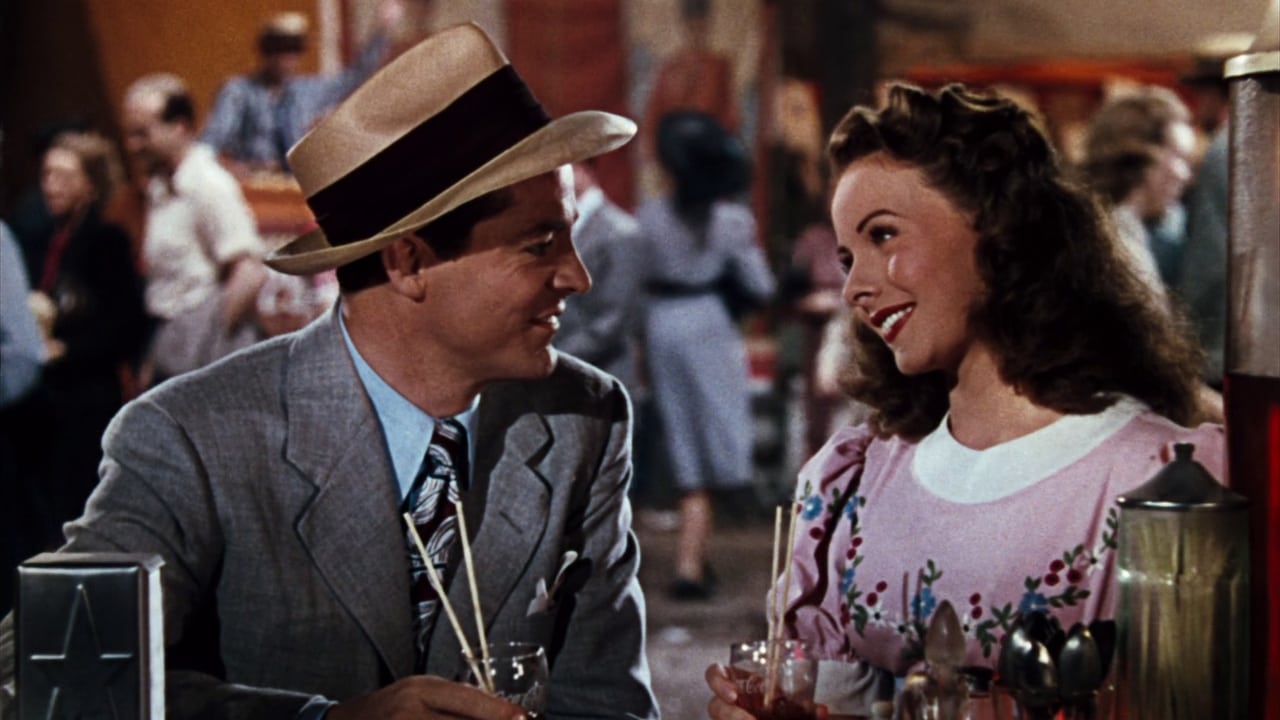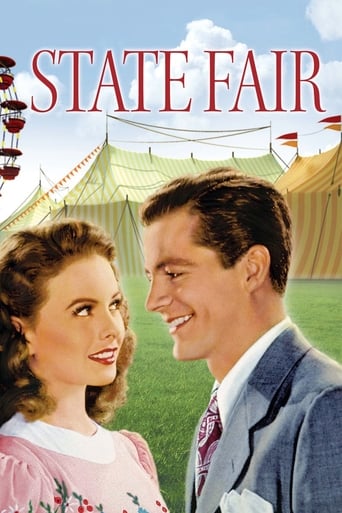


Good story, Not enough for a whole film
... View MoreExpected more
... View Moreit is the rare 'crazy' movie that actually has something to say.
... View MoreThe biggest problem with this movie is it’s a little better than you think it might be, which somehow makes it worse. As in, it takes itself a bit too seriously, which makes most of the movie feel kind of dull.
... View MoreFarm family Frake, with discontented daughter Margy, head for the Iowa State Fair. On the first day, both Margy and brother Wayne meet attractive new flames; so does father's prize hog, Blue Boy.I really liked this film from the opening shots. The first song is great, and includes the phrase "dollars to doughnuts", which I always thought was a strange one. Now I know where it comes from. After that, it sort of goes downhill. Most of the songs are rather dated, and the overall romance stories are cheesy. Granted, this is supposed to be a stage musical, so it has to be rushed a little... but it seems off.I really liked the pig, though. More pig and more catchy tunes and this would be a definite winner.
... View MoreAs a number of people have pointed, this is not one of the GREAT Rodgers & Hammerstein...and it was originally produced for the film, as opposed to their other musicals that were first produced for Broadway and then later moved to the big screen. But while not great, it's darned good in an old-fashioned sort of way.The story revolves around a rural family who is getting ready to go to the State Fair. Mother will put her mincemeat and dill pickles up for judging. Father his prize hog. The son will go looking for a new love, and the daughter for her first real love. One will find what they are looking for, another will settle for the love back home.Jeanne Crain was almost always a delight on the big screen, and is no less so here. Will she find her first real love? Incidentally, Crain's singing performance here is dubbed, and in my view, by a not very good singer. Dana Andrews is decent as the sophisticated reporter she sets her sights on. Dick Haymes plays the brother, and he displays his very nice singing voice. Vivian Blaine is who he falls in love with. I like Blaine, but here her red hair just didn't look real. Charles Winninger is adorable as the father. Fay Bainter wonderful as the mother...although she certainly had better roles. Donald Meek plays the tipsy mincemeat judge. Frank McHugh has a crucial role with little screen time. Percy Kilbride plays a character not unlike most that he played in his career. Harry Morgan has a brief role as a carnival barker.In terms of songs, "Our State Fair" is catchy, as is "Isn't It Kind of Fun?". But the two standouts are "It Might as Well Be Spring" and "It's A Grand Night For Singing".It's all very pleasant, though not spectacular. Certainly worth a watch, and the DVD set I have also has the later remake with Ann-Margaret and Pat Boone (which is less successful, although I love the song "Sweet Hog Of Mine" with Tom Ewell). If you like musicals, it's worth watching.
... View MoreIf you've read my reviews of musicals, then you know that I watch most of them only so that I can heckle them like Mike, Servo and Crow do to the crummy movies that Dr. Forrester and TV's Frank send them on "Mystery Science Theater 3000". One of my cracks to the arch-hokey "State Fair" was during the taste-testing scene: I said that one of the characters had put LSD in the punch. I heckled the equally hokey 1962 version to a lesser extent, just since I'm not tempted to heckle Ann-Margret.Yes, you probably think that I'm some sort of curmudgeon. Look, these big pompous movies set themselves up to get mocked. If we can make fun of famous people, then why not the movies in which they star? And no, you can't give me any of this "Golden Age of Cinema" mumbo-jumbo; there were just as many bad movies back then as there are now. It's just that we only remember the good movies. The point is that this is just the sort of movie that begs to get given a "Weird Al" Yankovic-style treatment. And just to remind you that I'm not playing favorites, I did the same with "My Dream Is Yours", "Show Boat", "Oklahoma!", "The King and I", "Mary Poppins" and "The Sound of Music". "MST3K" would have a field day with all these flicks. As for me, I'd like to see Quentin Tarantino remake them.
... View MoreI've lost track of how often I've seen this beautiful, corny gem but the last time won't be the last time."State Fair" has none of the complexities of most of R and H's work, but it still has excellent songs and lovable characters. Where to start? First of all, Dick Haymes was one of the best singers of his era. (His brother, Bob, made a few records, for Decca, I believe under the name of Hayme and eggs. Oh well).Back to the matter at hand. Jeanne Crain was a) beautiful b) gorgeous. She makes most of todays actresses look like mud. Vivian Blaine is lovely and talented, never getting the Hollywood recognition she deserved. Dana Andrews, who graces every third 20th Century Fox picture, proves charming and winning. The characters are unbeatable - Fay Bainter, Charles Winninger, Harry Morgan, Donald Meek, and Frank McHugh as a lovable songplugger (a contradiction in terms).The hog hogged its scenes (I had to say that). Nowadays, he would probably have lines rather than settling for snorting.One word that comes to mind about this movie is charming. I lived in Iowa for several years, but never made it to the state fair. The movie was second best.It is state great not just state fair.P.S. I loved the scene where Andrews, a reporter who doesn't take too many notes, comes to the end of a roller coaster ride and, when told to get off, flashes a press pass. My wife said something like how unethical. I've been a reporter for a major newspaper for 30 years (still writing free-lance) and I had to remind her of nice, free days we enjoyed at a major theme park whenever a new attraction was announced).
... View More